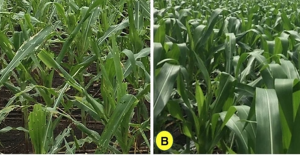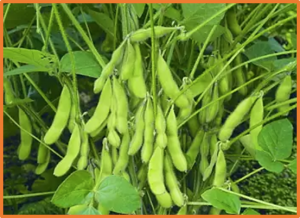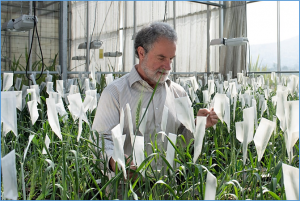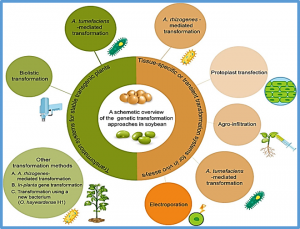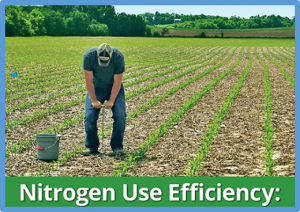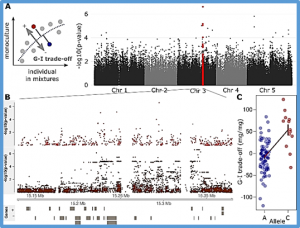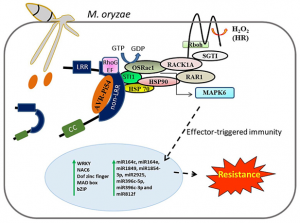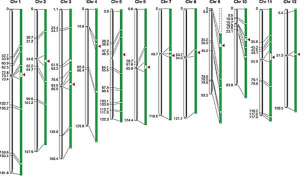The fall armyworm [Spodoptera frugiperda (J.E. Smith); FAW] has emerged as a serious pest since 2016 in Africa, and since 2018 in Asia, affecting the food security and livelihoods of millions of smallholder farmers, especially those growing maize. Sustainable control of FAW requires implementation of integrated pest management strategies, in which host plant resistance is one of the key components. Significant strides have been made in breeding elite maize lines and hybrids with native genetic resistance to FAW in Africa, based on the strong foundation of insect-resistant tropical germplasm developed at the International Maize and Wheat Improvement Center, Mexico.
Breeding disease-resistant soybean [Glycine max (L.) Merr.] varieties is a common goal for soybean breeding programs to ensure the sustainability and growth of soybean production worldwide. However, due to global climate change, soybean breeders are facing strong challenges to defeat diseases. Marker-assisted selection and genomic selection have been demonstrated to be successful methods in quickly integrating vertical resistance or horizontal resistance into improved soybean varieties
Increasing world populations as well as pandemics and regional conflicts require more and consistent crop production. Plant breeding is important to cope with climate change impacts, complementing crop management and policy interventions to ensure global food production. However, changes in environmental factors also affect the objectives, efficiency, and genetic gains of the current plant breeding system.
Soybean is one of the important food, feed, and biofuel crops in the world. Soybean genome modification by genetic transformation has been carried out for trait improvement for more than 4 decades. However, compared to other major crops such as rice, soybean is still recalcitrant to genetic transformation, and transgenic soybean production has been hampered by limitations such as low transformation efficiency and genotype specificity, and prolonged and tedious protocols.
The role of soybean 14-3-3 gene (Glyma05g29080) in defense against white mold and in nodulation was investigated by loss-of-gene-function with CRISPR-Cas9 editing and RNAi silencing. Particle bombardment was used to introduce the CRISPR expression cassette to target the soybean 14-3-3 gene and an RNAi construct to silence gene transcription. Transmission of the edited14-3-3 gene and the RNAi construct was confirmed in their respective progeny.
Teosinte, the wild ancestor of maize (Zea mays subsp. mays), has three times the seed protein content of most modern inbreds and hybrids, but the mechanisms that are responsible for this trait are unknown1,2. Here we use trio binning to create a contiguous haplotype DNA sequence of a teosinte (Zea mays subsp. parviglumis) and, through map-based cloning, identify a major high-protein quantitative trait locus, TEOSINTE HIGH PROTEIN 9 (THP9),
Historic yield advances in the major crops have, to a large extent, been achieved by selection for improved productivity of groups of plant individuals such as high-density stands. Research suggests that such improved group productivity depends on “cooperative” traits (e.g., erect leaves, short stems) that—while beneficial to the group—decrease individual fitness under competition. This poses a problem for some traditional breeding approaches, especially when selection occurs at the level of individuals,
Rice is a global food grain crop for more than one-third of the human population and a source for food and nutritional security. Rice production is subjected to various stresses; blast disease caused by Magnaporthe oryzae is one of the major biotic stresses that has the potential to destroy total crop under severe conditions. In the present review, we discuss the importance of rice and blast disease in the present and future global context,
Base editing is a precision genome-editing approach that is widely utilized to generate single-nucleotide variants (SNVs) in genomes. Here, we present a protocol to perform targeted adenine (A)-to-guanine (G) substitution in rice using adenine base editor (ABE). We detail the design of sgRNA, CRISPR plasmid construction, rapid genetic transformation of rice, and genotyping of editing events. This protocol can be applied to cytosine base editing in rice as well.
Root hairs (RH) are a single-cell extension of root epidermal cells. In low phosphorus (LP) availability, RH length and density increase thus expanding the total root surface area for phosphate (Pi) acquisition. However, details on genes involved in RH development and response to LP are missing in an agronomically important leguminous crop, chickpea. To elucidate this response in chickpea, we performed tissue-specific RNA-sequencing and analyzed the transcriptome modulation for RH and root without RH (Root-RH) under LP.


 Curently online :
Curently online :
 Total visitors :
Total visitors :
